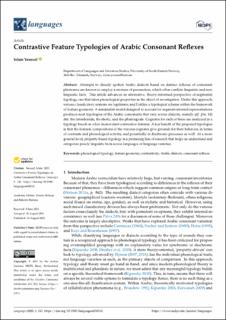| dc.description.abstract | Attempts to classify spoken Arabic dialects based on distinct reflexes of consonant phonemes are known to employ a mixture of parameters, which often conflate linguistic and non-linguistic facts. This article advances an alternative, theory-informed perspective of segmental typology, one that takes phonological properties as the object of investigation. Under this approach, various classificatory systems are legitimate; and I utilize a typological scheme within the framework of feature geometry. A minimalist model designed to account for segment-internal representations produces neat typologies of the Arabic consonants that vary across dialects, namely qāf, ǧīm, kāf, ḍād, the interdentals, the rhotic, and the pharyngeals. Cognates for each of these are analyzed in a typology based on a few monovalent contrastive features. A key benefit of the proposed typologies is that the featural compositions of the various cognates give grounds for their behavior, in terms of contrasts and phonological activity, and potentially in diachronic processes as well. At a more general level, property-based typology is a promising line of research that helps us understand and categorize purely linguistic facts across languages or language varieties. | en_US |

